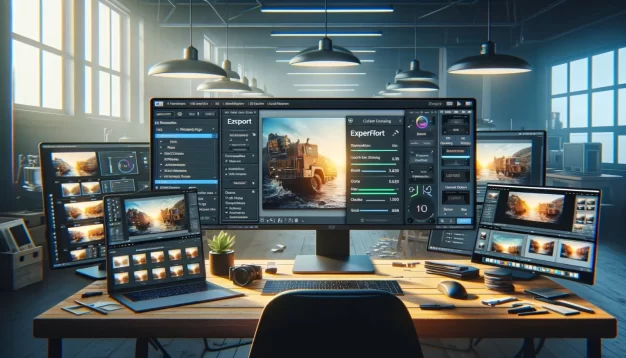Output and Exporting
Unlock the secrets to perfect photo exports with our expert tips and format insights.

Understanding Photo Output
Mastering photo output is crucial for photographers who want their work to be presented accurately and beautifully, whether it’s on screen or in print.
Different File Formats
Selecting the right file format is vital. JPEGs are ubiquitous but can degrade with repeated editing and saving. TIFFs offer lossless quality at the expense of larger file sizes. PNGs are excellent for web use, and RAW files provide the most data for post-processing.
Resolution and Size Considerations
The resolution, typically measured in pixels, defines an image’s detail. Higher resolution photos allow for larger prints without losing quality. Size considerations are also key; larger files offer more detail but can be unwieldy and slow to work with.
Color Profiles and Spaces
Different devices interpret colors differently. That’s where color profiles and spaces like sRGB and Adobe RGB come into play. sRGB is the standard for web, while Adobe RGB offers a wider gamut suitable for print.
Exporting from Editing Software
Common Export Settings
Familiarity with export settings is paramount. Adjustments include file format, resolution, and color space, ensuring the final image matches intended use.
Adjusting Quality and Compression
Balancing quality and compression is an art. Higher quality means larger files, while too much compression can lead to artifacts. Striking the right balance preserves image integrity and usability.
Saving Presets for Efficiency
Creating presets for different output scenarios streamlines workflow and ensures consistency. It’s a simple yet powerful way to maintain efficiency without sacrificing quality.
Printing Considerations
DPI and PPI Explained
DPI (dots per inch) and PPI (pixels per inch) are often confused. DPI relates to printers, while PPI refers to digital screens. Understanding this distinction is critical for high-quality prints.
Choosing the Right Paper Type
Paper type impacts print quality. Glossy papers accentuate colors and contrasts, while matte papers offer a subtler, textured finish. The choice can make or break the final presentation of a print.
Color Calibration for Print
Color calibration ensures that what you see on your monitor is what you get in print. It’s a step often overlooked, much to the detriment of print authenticity.
Web and Digital Display
Optimizing for Online Platforms
Images for web use should be optimized for quick loading without sacrificing visual quality. This means finding the sweet spot between resolution and file size.
Resizing for Social Media
Each social platform has its own image specifications. Ignoring these can result in poor display of your work, cutting off vital details or introducing unwanted compression.
Using Watermarks for Protection
Watermarks can deter theft but must be used judiciously to avoid detracting from the image. A subtle, well-placed watermark can serve as both protection and branding.
Archiving and File Management
Organizing Your Exported Photos
A systematic approach to organizing photos saves time and headaches. Consistent folder structures and naming conventions ease retrieval and management.
Backup Strategies for High-Resolution Files
High-resolution files are both a blessing and a curse. While they provide exquisite detail, they’re also data hogs. Employing solid backup strategies ensures they’re safe without clogging up primary storage.
Versioning and File Naming Conventions
Implementing versioning and logical file naming conventions avoids confusion and data loss. It’s a critical practice for both individual and collaborative workflows.
Advanced Exporting Techniques
Batch Processing Exports
Batch processing can be a godsend for large volumes of images, saving time and maintaining uniformity across a body of work.
Sharpening for Final Output
Sharpening should be tailored to the intended output. Over-sharpening is a one-way ticket to an artificial look, while under-sharpening can leave images looking soft.
Soft Proofing for Accurate Results
Soft proofing simulates how images will appear in print. It’s an advanced technique that can save resources and ensure satisfaction before committing to ink.
Common Pitfalls to Avoid
Over-Compression and Quality Loss
Beware the temptation of over-compression. It’s a disservice to your work, leading to pixelation and banding that can ruin an otherwise stellar image.
Ignoring Aspect Ratios and Cropping
Aspect ratios are not just numbers; they’re the dimensions of your visual story. Ignoring them can result in awkward crops that disfigure your composition.
Misunderstanding File Size vs. Quality
File size and quality are not the same. A large file can be of poor quality, and a small file can be of high quality. Understanding the relationship between the two is essential for mastering photo output.
Leaving you with this zinger: Treating all your images with the same export settings is like wearing socks with sandals—just because you can doesn’t mean you should. Tailor your approach and watch your photographs stand out for all the right reasons.